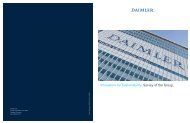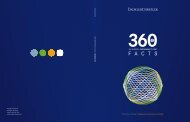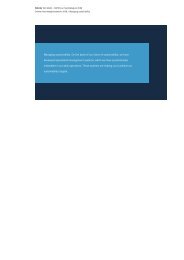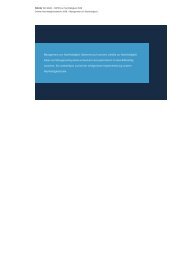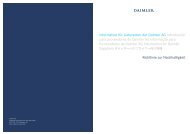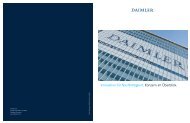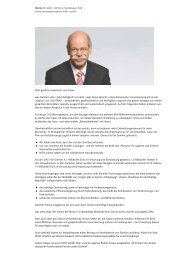Dear readers, This report describes what Daimler means by ...
Dear readers, This report describes what Daimler means by ...
Dear readers, This report describes what Daimler means by ...
Create successful ePaper yourself
Turn your PDF publications into a flip-book with our unique Google optimized e-Paper software.
<strong>Daimler</strong> 360 GRAD - FAKTEN zur Nachhaltigkeit 2008<br />
<strong>Daimler</strong> Nachhaltigkeitsbericht 2008 / Environmental protection, innovation, and safety / Products and product use / Airborne emissions<br />
Percentage share of Mercedes-Benz and smart diesel passenger cars sold in Europe in 2007 that meet<br />
mandatory and planned emissions standards<br />
CO<br />
in g/km<br />
HC NOx<br />
in g/km<br />
Limit values<br />
NOx<br />
in g/km<br />
Particulates<br />
in g/km<br />
Percentage share of Mercedes-<br />
Benz and smart diesel<br />
passenger cars that meet<br />
the respective limit values<br />
Euro 4 0.50 0.25 0.30 0.025 91 percent<br />
Euro 5 1 0.50 0.18 0.23 0.005 9 percent<br />
1 The Euro 5 limits are binding for all new vehicles as of January 1, 2011. At present no vehicle has been registered on the basis of Euro 5.<br />
BLUETEC is helping us achieve our goal of making diesels as clean as gasoline engines and thus ready for future<br />
emission limits worldwide.<br />
In the BLUETEC system, <strong>Daimler</strong> brings together various technical features for reducing all relevant emission<br />
components in diesel passenger cars and commercial vehicles. The system includes optimized combustion<br />
engines, an oxidizing catalytic converter, and a diesel particulate filter. It also uses innovative technologies to<br />
reduce nitrogen oxide emissions (either an enhanced DeNOx storage catalytic converter with an SCR catalytic<br />
converter, or the latter plus injection of an additive known as AdBlue).<br />
In October 2006, the world’s first BLUETEC passenger car – the Mercedes-Benz E 320 BlueTEC (with a DeNOx<br />
storage catalytic converter and an SCR catalytic converter) – was launched on the North American market.<br />
It was followed in December 2007 <strong>by</strong> the E 300 BlueTEC in Europe. Starting in 2008, three other BLUETEC<br />
models will be offered on the U.S. market – in the R-Class, the M-Class, and the GL-Class. All three will initially<br />
be available in the U.S. only, where they meet the extremely stringent Bin 5 and ULEV emission standards.<br />
Mercedes-Benz is thus the first manufacturer able to offer diesel SUVs in all 50 U.S. states. Beginning in 2010,<br />
BLUETEC will also be available as a technology package in combination with a hybrid module, initially in the E<br />
300 BlueTEC HYBRID and the S 400 BlueTEC HYBRID.<br />
Low-emission commercial vehicles. Thanks to BLUETEC, <strong>Daimler</strong> commercial vehicles already comply with the<br />
Euro V emission limits that will not go into effect until 2009 for new vehicles. With this technology base, such<br />
vehicles are also ready for the next phase of emission legislation – Euro VI. We’re also utilizing the technology to<br />
ensure that our commercial vehicles and buses comply with the stringent emission limits that will go into effect<br />
in the NAFTA region and Japan (EPA 10 and JP 09, respectively).<br />
The foundation for BLUETEC is provided <strong>by</strong> further optimized engines featuring higher peak pressure and<br />
compression ratios that result in cleaner combustion, fewer particulates, and – depending on the engine variant<br />
– higher output. Such engines also consume up to 6 percent less fuel than those installed in Euro III vehicles.<br />
Once exhaust gases leave the engine, they are brought into contact with AdBlue that is injected from a special<br />
tank into the hot exhaust gas flow, where it reacts to form ammonia. The gases are treated in an SCR catalytic<br />
converter before they are emitted into the atmosphere. Here, a catalytic reaction transforms nitrogen oxides into<br />
harmless nitrogen and water. The AdBlue itself is stored in a separate tank that can be refilled using a normal<br />
pump. Around one liter of AdBlue is required for 25 liters of diesel fuel.<br />
More than 150,000 commercial vehicles equipped with the AdBlue system have been handed over to customers<br />
since series production of BLUETEC technology was launched at the end of 2004. Starting with heavy-duty longdistance<br />
trucks, we have gradually expanded our range of BLUETEC 5 vehicles right down to light trucks for<br />
short-range distribution.



